International Journal of Intelligent Systems and Applications @ijisa
Статьи журнала - International Journal of Intelligent Systems and Applications
Все статьи: 1214
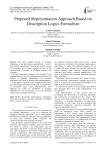
Proposed Representation Approach Based on Description Logics Formalism
Статья научная
The most familiar concept in Artificial intelligence is the knowledges representation. It aims to find explicit symbolization covering all semantic aspects of knowledge, and to make possible the use of this representation to produce an intelligent behavior like reasoning. The most important constraint is the usability of the representation; it's why the structures used must be well defined to facilitate manipulation for reasoning algorithms which leads to facilitate their implementation. In this paper we propose a new approach based on the description logics formalism for the goal of simplification of description logics system implementation. This approach can reduce the complexity of reasoning Algorithm by the vectorisation of concept definition based on the subsumption hierarchy.
Бесплатно
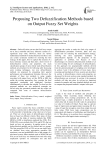
Proposing Two Defuzzification Methods based on Output Fuzzy Set Weights
Статья научная
Defuzzification converts the final fuzzy output set of fuzzy controller and fuzzy inference systems to a significant crisp value. However, there are various mathematical methods for defuzzification, but there is not any certain systematic method for choosing the best strategy. In this paper, first we explain the structure of a fuzzy inference system and then after a short review of defuzzification criteria and properties, the main classification groups of most widely used defuzzification methods are presented. In the following after discussing some existing techniques, two new defuzzification methods are proposed by presenting their general performance and computational formulas. However, the principle of these two methods is using weights associated with output fuzzy set like WFM or QM, but unlike the existing approaches, they consider the final aggregated consequent and implicated functions simultaneously to calculate the weights. To show how the proposed methods act, two numerical examples are solved using the presented methods and the results are compared with some of common defuzzification techniques.
Бесплатно

Статья научная
Recently, series compensation is widely used in transmission. However, this creates several problems to conventional protection approaches. This paper presents overcurrent and distance protection schemes, for fault classification in transmission lines with thyristor controlled series capacitor (TCSC) using support vector machine (SVM). The fault classification task is divided into four separate subtasks (SVMa, SVMb, SVMc and SVMg), where the state of each phase and ground is determined by an individual SVM. The polynomial kernel SVM is designed to provide the optimal classification conditions. Wide variations of load angle, fault inception angle, fault resistance and fault location have been carried out with different types of faults using PSCAD/EMTDC program. Backward faults have also been included in the data sets. The proposed technique is tested and the results verify its fastness, accuracy and robustness.
Бесплатно
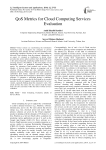
QoS Metrics for Cloud Computing Services Evaluation
Статья научная
Cloud systems are transforming the Information Technology trade by facultative the companies to provide admission to their structure and also software products to the membership foundation. Because of the vast range within the delivered Cloud solutions, from the customer’s perspective of an aspect, it's emerged as troublesome to decide whose providers they need to utilize and then what's the thought of his or her option. Especially, employing suitable metrics is vital in assessing practices. Nevertheless, to the most popular of our knowledge, there's no methodical explanation relating to metrics for estimating Cloud products and services. QoS (Quality of Service) metrics playing an important role in selecting Cloud providers and also optimizing resource utilization efficiency. While many reports have got to devote to exploitation QoS metrics, relatively not much equipment supports the remark and investigation of QoS metrics of Cloud programs. To guarantee a specialized product is published, describing metrics for assessing the QoS might be an essential necessity. So, this text suggests various QoS metrics for service vendors, especially thinking about the consumer’s worry. This article provides the metrics list may stand to help the future study and also assessment within the field of Cloud service's evaluation.
Бесплатно
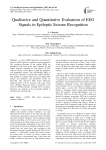
Qualitative and Quantitative Evaluation of EEG Signals in Epileptic Seizure Recognition
Статья научная
A chaos-ANFIS approach is presented for analysis of EEG signals for epileptic seizure recognition. The non-linear dynamics of the original EEGs are quantified in the form of the hurst exponent (H) and largest lyapunov exponent (λ). The process of EEG analysis consists of two phases, namely the qualitative and quantitative analysis. The classification ability of the H and λ measures is tested using ANFIS classifier. This method is evaluated with using a benchmark EEG dataset, and qualitative and quantitative results are presented. Our inter-ictal EEG based diagnostic approach achieves 97.4% accuracy with using 4-fold cross validation. Diagnosis based on ictal data is also tested in ANFIS classifier, reaching 96.9% accuracy. Therefore, our method can be successfully applied to both inter-ictal and ictal data.
Бесплатно
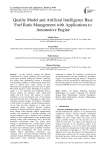
Статья научная
In this research, manage the Internal Combustion (IC) engine modeling and a multi-input-multi-output artificial intelligence baseline chattering free sliding mode methodology scheme is developed with guaranteed stability to simultaneously control fuel ratios to desired levels under various air flow disturbances by regulating the mass flow rates of engine PFI and DI injection systems. Modeling of an entire IC engine is a very important and complicated process because engines are nonlinear, multi inputs-multi outputs and time variant. One purpose of accurate modeling is to save development costs of real engines and minimizing the risks of damaging an engine when validating controller designs. Nevertheless, developing a small model, for specific controller design purposes, can be done and then validated on a larger, more complicated model. Analytical dynamic nonlinear modeling of internal combustion engine is carried out using elegant Euler-Lagrange method compromising accuracy and complexity. A baseline estimator with varying parameter gain is designed with guaranteed stability to allow implementation of the proposed state feedback sliding mode methodology into a MATLAB simulation environment, where the sliding mode strategy is implemented into a model engine control module (“software”). To estimate the dynamic model of IC engine fuzzy inference engine is applied to baseline sliding mode methodology. The fuzzy inference baseline sliding methodology performance was compared with a well-tuned baseline multi-loop PID controller through MATLAB simulations and showed improvements, where MATLAB simulations were conducted to validate the feasibility of utilizing the developed controller and state estimator for automotive engines. The proposed tracking method is designed to optimally track the desired FR by minimizing the error between the trapped in-cylinder mass and the product of the desired FR and fuel mass over a given time interval.
Бесплатно
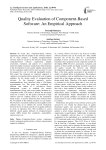
Quality evaluation of component-based software: an empirical approach
Статья научная
In recent days, component-based software engineering has become popular in the software industry for its reuse property. A suitable component-based software model is crucial for the effective design of the component-based software engineering. Quality assessment, evaluation, and analysis of a component model are highly essential to maintain the efficient design in the development of such system. Quality measurement for the component model will be more accurate, if it can be measured by a set of valid and meaningful metrics. This paper has proposed an empirical approach to validate a set of quality metrics along with a set of quality attributes for the design model of component-based software. In the proposed approach, metrics interdependencies have described using a Chi-Square non-parametric test. This paper has considered six different case studies of a well-known library management system to establish the metrics interdependency along with several quality attributes of a component model. This helps to identify the practically useful set of metrics for the quality assessment of high cohesive and low coupling metrics of the component-based system. A massive dataset has been collected from the 34 students of the institute on these six case studies. The Pearson's correlation method has been applied on the collected data set to identify the several correlations between the set of metrics and the set of quality attributes in terms of operation time. This facilitates to assess different crucial quality attributes of component-based system (CBS) design like complexity, analyzability, expressiveness etc.
Бесплатно
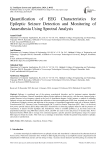
Статья научная
Epilepsy is considered one of the primary neurological disorders, and its treatment requires abundant technological assistance. General Anaesthesia induces distinct patterns in brain activity, with the most common being a gradual increase in low-frequency signals as the level of Anaesthesia deepens. In this instance, a method of validating epileptic seizures and Anaesthesia through the utilization of electroencephalogram (EEG) data, acquired non-invasively, is introduced. Epileptic seizures and detection of the presence of Anaesthesia approaches make use of discrete Laplace Transformation (LT), Discrete Cosine Transformation (DCT), and Fast Fourier Transform (FFT). Here, it is discussed how power spectral analysis (PSA) helps study EEG characteristics in detecting epileptic behavior and the presence of Anaesthesia. A dataset of EEG (Epileptic and Anaesthesia), which is available publicly [1,2], has been used in the propounded technique using FIR filters and LT, DCT, and FFT are used to store and process 16 channel data. Power Spectrum Density (PSD) and its average were contrasted against a specific spectrum and frequency range of a typical EEG signal to obtain the results. This work uses a technique to determine whether the patient being studied is epileptic and awake or anesthetized.
Бесплатно
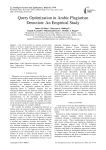
Query Optimization in Arabic Plagiarism Detection: An Empirical Study
Статья научная
This article describes an ongoing research which intends to develop a plagiarism detection system for Arabic documents. We developed different heuristics to generate effective queries for document retrieval from the Web. The performance of those heuristics was empirically evaluated against a sizeable corpus in terms of precision, recall and f-measure. We found that a systematic combination of different heuristics greatly improves the performance of the document retrieval system.
Бесплатно
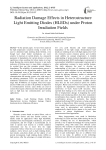
Статья научная
In the present paper, we have been analyzed the high temperature variations testing in order to be used to determine light emitting diode lifetime, even though laser diode failure mechanisms are more sensitive to increases in current density. As a measured parameter of degradation, the current density is of great significance when searching for failure modes in a laser diode. Raising the current density however, is not really indicative of lifetime since it is more likely a situation to be avoided than one that simulates normal lifetime degradation. The reliability of semiconductor sources is very dependent on the degradation modes. This paper has investigated some of the degradation modes and capabilities of typical LEDs currently used in many communication and sensing systems over wide range of the affecting parameters. LED’s are typically used in multimode transmission systems where data rates no larger than 50 Mbit/sec are required. They have larger spectral widths and can add to the problem of dispersion in communications systems. Laser diodes are used in systems that require coherent and often single mode light such as high data rate communications and sensing applications.
Бесплатно

Rate of Convergence of the Sine Imprecise Functions
Статья научная
We convert polynomial function of degree nth into imprecise form to obtain an important point called conversion point. For some particular region, we collect the finite number of data points to obtain the most economical function called imprecise function. Conversion point of the functions is shown with the help of MUPAD graph. Further we study the area of the imprecise function occurred by the multiplication of sine function to know how much variation of the imprecise functions are obtained for the respective intervals. For different imprecise polynomial we study level of the rate of convergence.
Бесплатно
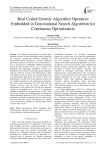
Статья научная
The objective of this paper is to propose three modified versions of the Gravitational Search Algorithm for continuous optimization problems. Although the Gravitational Search Algorithm is a recently introduced promising memory-less heuristic but its performance is not so satisfactory in multimodal problems particularly during the later iterations. With a view to improve the exploration and exploitation capabilities of GSA, it is hybridized with well-known real coded genetic algorithm operators. The first version is the hybridization of GSA with Laplace Crossover which was initially designed for real coded genetic algorithms. The second version is the hybridization of GSA with Power Mutation which also was initially designed for real coded genetic algorithms. The third version hybridizes the GSA with both the Laplace Crossover and the Power mutation. The performance of the original GSA and the three proposed variants is investigated over a set of 23 benchmark problems considered in the original paper of GSA. Next, all the four variants are implemented on 30 rotated and shifted benchmark problems of CEC 2014. The extensive numerical, graphical and statistical analysis of the results show that the third version incorporating the Laplace Crossover and Power mutation is a definite improvement over the other variants.
Бесплатно
Real Time Hand Detection & Tracking for Dynamic Gesture Recognition
Статья научная
In the recent year gesture recognition has become the most intuitive and effective communication technique for human interaction with machines. In this paper we are going to work on hand gesture recognition and interpret the meaning of it from video sequences. Our work takes place in following three phases: 1. Hand Detection & Tracking 2. Feature extraction 3. Gesture recognition. We have started proposed work with first step as applying hand tracking and hand detection algorithm to track hand motion and to extract position of the hand. Trajectory based features are being drawn out from hand and used for recognition process and hidden markov model is being design for each gesture for gesture recognition. Hidden Markov Model is basically a powerful statistical tool to model generative sequences. Our method is being tested on our own data set of 16 gestures and the average recognition rate we have got is 91%. With proposed methodology gives the better recognition results compare with the traditional approaches such as PCA, ANN, SVM, DTW and many more.
Бесплатно
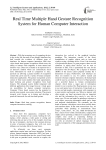
Real Time Multiple Hand Gesture Recognition System for Human Computer Interaction
Статья научная
With the increasing use of computing devices in day to day life, the need of user friendly interfaces has lead towards the evolution of different types of interfaces for human computer interaction. Real time vision based hand gesture recognition affords users the ability to interact with computers in more natural and intuitive ways. Direct use of hands as an input device is an attractive method which can communicate much more information by itself in comparison to mice, joysticks etc allowing a greater number of recognition system that can be used in a variety of human computer interaction applications. The gesture recognition system consist of three main modules like hand segmentation, hand tracking and gesture recognition from hand features. The designed system further integrated with different applications like image browser, virtual game etc. possibilities for human computer interaction. Computer Vision based systems has the potential to provide more natural, non-contact solutions. The present research work focuses on to design and develops a practical framework for real time hand gesture.
Бесплатно
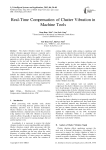
Real-Time Compensation of Chatter Vibration in Machine Tools
Статья научная
The chatter vibration stands for a sudden relative vibration appeared between a material and a tool while processing with a machine. This vibration is a factor that seriously affects the quality of processed materials as well as being a factor which causes serious damages to the tool and the machine. This study is related to the detection and compensation of chatter vibration that can compensate chatter vibration faster and produce processed goods with more precision by autonomous compensation. The above-mentioned chatter vibration compensator includes the chatter vibration sensor and the chatter compensator that estimates the compensation value according to the sensor detecting the chatter vibration of machine tool and the chatter vibration detected from the sensor while having a feature of being organized by interlocking with the machine tool controller.
Бесплатно
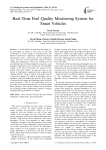
Real-Time Fuel Quality Monitoring System for Smart Vehicles
Статья научная
A novel method of monitoring the quality i.e. the percentage of purity of diesel fuel in real-time environment in smart vehicles is presented here. The method incorporates temperature compensated density measurement using a dual load cell and temperature sensor. The mass of the small fixed volume of diesel sample and temperature of diesel are measured by the pre-calibrated load cell based amplifier set up and a smart miniature temperature sensor respectively. The amplified voltage of the load cell provides the measure of the density of the fuel. Further, the measured value of fuel density is temperature compensated and compared with standard reference values to indicate percentage of purity of the diesel sample. The method is automated with an intelligent virtual instrument that provides all the means of testing the fuel sample and displaying results with high level of accuracy ~ 99.8 %. The model offers a way of providing vital real time information to user and has great future prospects. Also, the data collected can be analyzed for developing complex mathematical models to suggest optimized driving parameters for vehicles.
Бесплатно
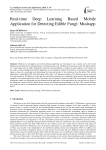
Real-time Deep Learning Based Mobile Application for Detecting Edible Fungi: Mushapp
Статья научная
Mushroom consumption and wild mushroom gathering are increasing in our country and in the world. Mushroom poisoning has an important place in food poisoning cases. Mushroom poisoning accounts for approximately 7% of poisoning cases in adults. Mushroom collection and consumption is common in many regions of our country. In this study, a deep learning based mobile application was developed to reduce the incidence of mushroom poisoning by taking a photo of a mushroom and determining the type and toxicity of the mushroom from the photo. This mobile application is called MushAPP. In the first phase of the study, 5150 mushroom images of 20 mushroom species were used to create the dataset. The dataset was then pre-processed and converted into a format that can be used by the deep learning algorithm. The mobile application side of the project was developed in Android Studio IDE environment. An artificial intelligence model was integrated into the designed mobile application. In the application, the type and toxicity status of the mushroom viewed from the mobile device camera are determined and presented to the user. The research findings were analyzed and it was determined that the accuracy rate of the application in detecting the mushroom species was 99.8%.
Бесплатно
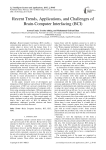
Recent Trends, Applications, and Challenges of Brain-Computer Interfacing (BCI)
Статья научная
Brain-Computer Interfacing (BCI) enables a communication pathway that is used to directly control certain object or device with the human brain. It is possible to acquire data from the brain with the help of sensors which essentially monitor the physical processes that occur in the brain and with the help of software we can direct a device accordingly. BCI introduces its users a new system that communicates in a special way without the use of muscles. BCI also provides a useful platform for the people with physical disabilities to conveniently perform certain tasks in our society. It uses brain imaging technologies which help in increasing the quality of the communication between humans and machines. There has been significant research effort in the past decade to explore different aspects of this promising field of technology. Previously, BCIs had limited functionality but due to recent advancement in technology it has attained the maturity of its own right by adding new trends and extra features to it. In this paper, research work of development and integration of both hardware and software in BCI and the advancements of BCI are surveyed considering all the possibilities of direct communication of computers with a brain using emerging technologies. Different approaches used up till now with an overview of the methodology are presented to make the reader understand its meaning and functionality in a compact way. This research paper will guide a beginner to end up with a thorough knowledge of what's, how's and why's of BCI. In addition, BCI applications, challenges, possible solutions and future directions have also been discussed.
Бесплатно
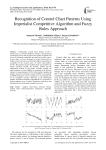
Статья научная
Traditionally, Control Chart Patterns (CCP) is widely used as a powerful method to measure, classify,analyze and interpret process data to improve the quality of products and service by detecting instabilities and justifying possible causes. In this study, we have developed an expert system that we called an expert system for control chart patterns recognition for recognition of the common types of control chart patterns (CCPs). The proposed system includes three main modules: the feature extraction module, the classifier module and the optimization module. In the feature extraction module, the multi-resolution wavelets (MRW) are proposed as the effective features for representation of CCPs. In the classifier module, the adaptive neuro-fuzzy inference system (ANFIS) is investigated. In ANFIS training, the vector of radius has a very important role for its recognition accuracy. Therefore, in the optimization module, imperialist competitive algorithm(ICA) is proposed for finding optimum vector of radius. Simulation results show that the proposed system has high recognition accuracy.
Бесплатно
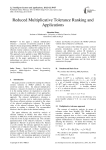
Reduced Multiplicative Tolerance Ranking and Applications
Статья научная
In this paper a reduced multiplicative tolerance - a measure of sensitivity analysis in multi-objective linear programming (MOLP) is presented. By using this new measure a method for ranking the set of efficient extreme solutions is proposed. The idea is to rank these solutions by values of the reduced tolerance. This approach can be applied to many MOLP problems, where sensitivity analysis is important for a decision maker. In the paper, applications of the presented methodology are shown in the market model and the transportation problem.
Бесплатно

